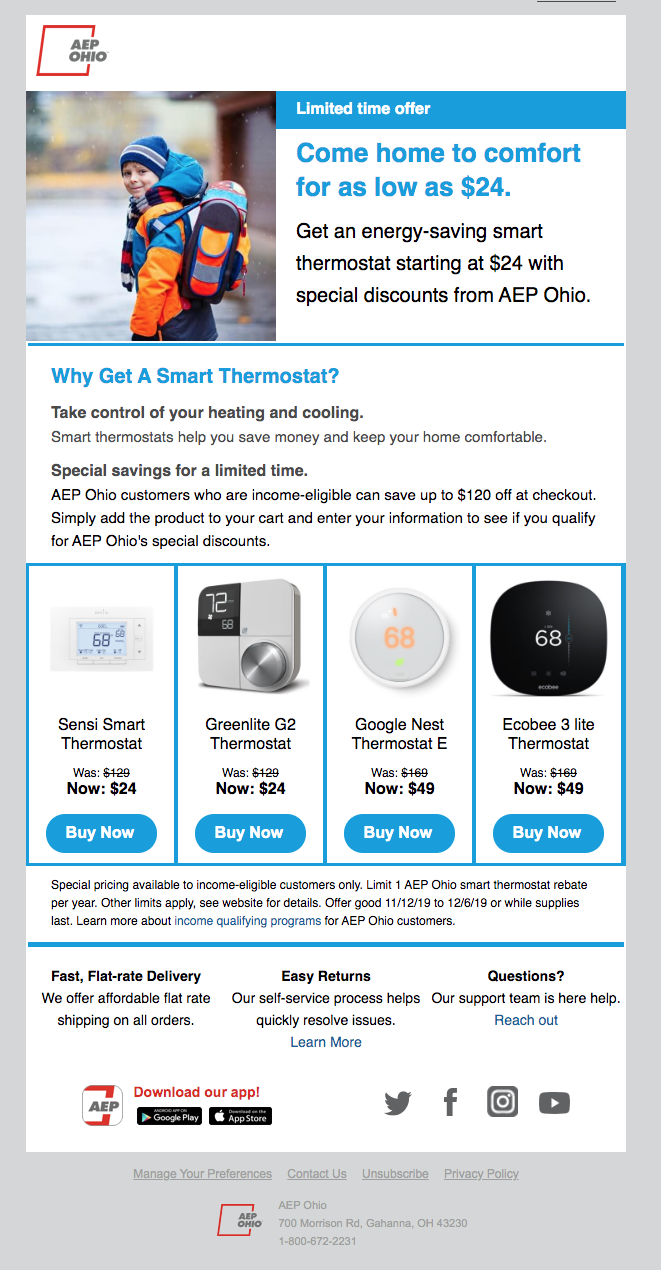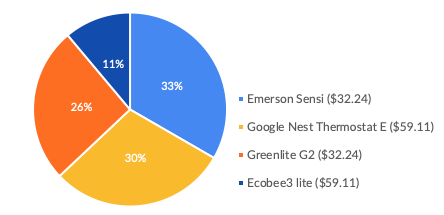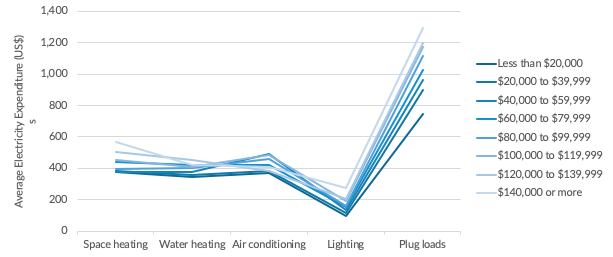Energy burden is real for low- and moderate-income households. The 22.9M U.S. households with incomes under $20k spend 7%+ of income on energy; another 27.3M earning up to $39k spend ~4%. Even with subsidies and traditional programs, ~1 in 3 households still report difficulty paying energy bills or maintaining adequate heating/cooling [1].
Working with AEP Ohio, we piloted a different approach: meet customers where they already shop, keep the experience simple, and remove friction at checkout. The result was a small but meaningful proof that an online utility marketplace—with instant eligibility, transparent net price, and choice—can modernize low-income offerings.
- $75 instant discount at checkout; customer co-pays ranged $32–$60 for four leading smart thermostats.
- 100% of surveyed participants were satisfied (83% “extremely satisfied”); 50% reported a more favorable view of the utility.
- Every respondent was a first-time smart-thermostat owner.
- Women made ~4× more online thermostat purchases than men.
- Co-investment: $0.85 of new private value leveraged per $1 of incentive.

How the pilot worked
Eligible AEP Ohio customers could choose from four smart thermostat models and buy online. At checkout, the platform:
- Verified eligibility instantly (including income qualification) within the purchase flow.
- Applied dynamic incentives based on the shopper’s inputs—income-qualified customers received an additional $25 on top of a $50 standard discount to reach the $75 total.
- Kept co-pays modest ($32–$60), encouraging ownership and high realization.

Partnerships that made it work
Delivered on the Enervee Marketplace with retail and manufacturer partners (Lightbulbs.com, Ecobee, Emerson, Google Nest, Greenlite), the pilot also leveraged supplier programs (e.g., Nest Power Project) to reduce net prices for income-eligible households.
These measures leveraged an average of $0.85 in new private investment for every $1 of incentive—helping program dollars go further.
What customers told us
- 100% satisfied; 83% “extremely satisfied.”
- 50% reported a more favorable view of AEP Ohio after using the program.
- Top likes: the ability to choose among models and the convenience of online shopping.
- Affordability: 100% said co-pays were manageable.
- First device: 100% were buying their first smart thermostat.
- Install: ~⅔ had a friend/family member install (no cost); ~⅓ DIY.
Why this model is noteworthy
Traditional low-income programs often bypass plug loads—appliances and devices that plug into outlets—even though they drive a large share of household electricity use. A retail, market-based channel can reach these categories cost-effectively and at scale.

Two complementary strategies for equity
- Nudge efficient choices without rebates. Use clear, market-wide guidance (e.g., the Enervee Score®) and total-cost insights to steer shoppers to efficient models they can afford today.
- Targeted instant discounts (and/or inclusive payments). For income-qualified shoppers, apply instant incentives at checkout—or offer Eco Financing—so the efficient option becomes the obvious option.
Takeaway
Empowering income-constrained customers to choose and buy efficient products online resonates. It also stretches public funds by blending private discounts and modest co-pays—while delivering a better customer experience and measurable savings.
Notes
FAQ
How was income qualification handled?
Eligibility was validated instantly online during checkout, so customers never had to leave the flow or upload paperwork.
Why require a customer co-pay?
Modest co-pays (in this pilot, $32–$60) encourage ownership and reduce waste while enabling more households served per program dollar.
Can this approach scale beyond thermostats?
Yes. The same marketplace + instant incentive pattern applies to plug-in appliances and devices that drive most residential electricity use—and can be purchased without contractors.
